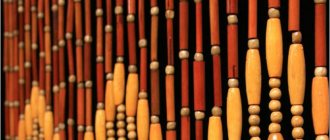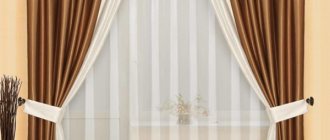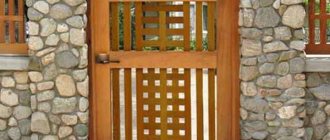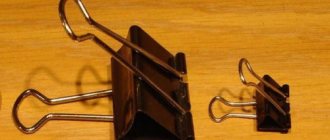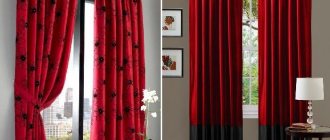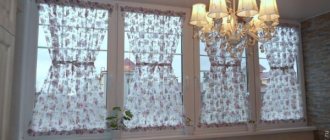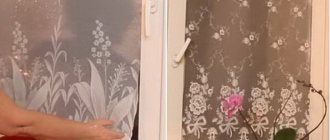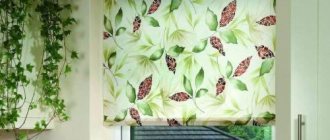List of required materials
It's simple:
Any fabric you like or ready-made curtain hanging on a rigid curtain rod
Ready-made rod cornice made of plastic, wood or metal
Eyelets in the amount of at least six pieces per linear meter of cornice
Thick eyelet tape or doublerin with a length 2.6 times the length of the cornice, 8 or 10 cm wide
A strip of fabric for making a cuff 25 cm wide, equal to the length of the eyelet tape + 5 cm each for side folds
Description
A grommet is an element that allows you to strengthen the edges of any material. It is a bushing with a cap on one side and an overhead washer on the other. There is a hole inside the product that is used for threading thread, rope, bowstring, or simply as a decorative decoration.
The eyelet consists of two parts - a ring and a bushing, also known as a block
Installation of eyelets is carried out in factories or manufacturing plants of various products. This element of attributes of each individual item has been widely used in several industries. Without this amplifier it is impossible to imagine ordinary shoes, or a modern notebook with recipes for a housewife.
Eyelets are used:
- in the production of outerwear;
- for making shoes;
- when producing home furnishing goods;
- for tourism and holiday purposes;
- in commercial activities;
- in the manufacture of shipping and maritime products;
- in office and printing.
As can be seen from the description of the areas of use of this wonderful accessory, it is widely used in almost all industries producing goods. Basically, the device is functional in nature, which consists in strengthening the edges of the material for subsequent threading of rope, cable or thin thread through it.
To install eyelets yourself, you need to know what hardware factories make them from.
- Steel.
- Aluminum.
- Brass.
- Copper (rare).
- Silver.
- Gold.
- Tree.
- Plastic.
- Stitching with thread.
Amplifiers are made from expensive metals by jewelry craftsmen or jewelry factories. Such elements serve as decorations for bracelets, shoulder straps of bags, shoes, and designer clothes. Aluminum products, as well as brass, are used for office/printing activities. Quarterly calendars, scrapbooks, notebooks and other products can be modified using eyelets.
Interesting. In the office, such a strengthening attribute is called a block. The printing industry workers themselves call it a “piccolo” ring.
A block is a grommet without a ring
Material calculation
To calculate, you need to take two measurements with a tape measure:
- length of the rod (rod) of the finished cornice between the end caps - distance d;
- height from the bottom of the eaves rod to the floor + diameter of the rod – H value.
We calculate the total width of a single canvas:
- L = d x 2.5 + 1.5 cm + 1.5 cm, where 2.5 is the average increase in the width of the canvas to form beautiful folds when the curtain is closed, and 1.5 cm is the side hems. The minimum value of the width coefficient for tulle is 2, for curtains – 1.5. The maximum value for cornices located far from the walls with large brackets is 4.
Height:
- h = H + 4 cm – 2 cm + 10 cm + 10 cm + 5 cm + 5 cm, where 4 cm is the height of the comb, 2 cm is the distance from the bottom of the curtain to the floor, 10 cm is the two upper hems equal to the width of the grommet tape , 5cm – two bottom folds.
Based on the dimensions obtained, we select a piece of fabric in the store.
If there is a need to install double swing curtains, then the calculation of the width L1 of each curtain will be different:
- L1 = d x 2.5 / 2 + 1.5 cm + 1.5 cm, where 2.5 is the average increase in the width of a single sheet. If size L1 exceeds the permissible width of a roll of fabric in a store, then the coefficient can be reduced to two for tulle and to one and a half for curtains. If this does not help due to the long length of the cornice, you can hem strips of this or another contrasting fabric on the sides of the fabric.
Calculation of material
In the case of making curtains with a cuff, the height of the canvas is calculated using the formula:
- h = H + 4 cm – 2 cm + 5 cm + 5 cm + 5 cm + 5 cm, where 4 cm is the height of the scallop, 2 cm is the distance from the bottom of the finished canvas to the floor, 5 cm is the upper and lower allowances.
Calculation of fabric for sewing:
LiveInternetLiveInternet
Quote from Tanianico
Read in full In your quotation book or community!
First, let's decide whether you really want to do this yourself. Of course, putting grommets on a curtain is not very difficult, almost anyone can do it, but it requires patience and some knowledge. As with any endeavor, installing curtain grommets yourself should make sense, as there are pros and cons.
Pros: if you follow through and do everything right, you will get new curtains, be proud of yourself and won’t have to pay anyone for the work. Plus, learning something new is always nice.
Cons: You will have to spend time searching, selecting and purchasing the materials needed to install the eyelets, sewing the curtain, calculating everything correctly, cutting out a lot of holes by hand (you will probably get a callus on your hand). And there is still a risk of spoiling the material. Aren't you scared? Then read on.
What you need to know before installing grommets.
1. What types of eyelets are there and which ones are better to choose?
Eyelets vary:
by the material from which they are made (metal or plastic);
in shape (round, curly);
by color (transparent, plain colors, imitating the color of metal, wood, leather and other materials);
according to the diameter of the internal hole (from 10.5 to 50 mm).
You need to choose eyelets depending on the curtain model you want to get as a result and the cornice on which it will be attached. Most often, round eyelets are installed to match the cornice, furniture fittings or curtain material. But if you want to focus on the eyelets themselves as a decorative element of the curtain, you can use curly eyelets. For example, grommets in the shape of a steering wheel or a dolphin for children's curtains in a marine style.
The diameter of the grommet hole should be 1.5 cm larger than the diameter of the rod (pipe) of the cornice. Otherwise, the curtain will not move well along the cornice, because the eyelets will get stuck on the rod.
As for the choice of grommet material, it is more practical to use plastic ones. They do not damage the curtain rod, move quietly along the curtain rod, and there is no risk that during washing the metal will oxidize and stain the curtain fabric with rust. Plastic eyelets can generally be removed for washing and then put back. In addition, plastic eyelets are cheaper than metal ones and do not require a special press to install them.
2. Where to buy eyelets and how much they cost.
The price of eyelets depends on their size, shape, material and quality. We do not recommend buying cheaper eyelets, as they are most likely of low quality. You probably don’t need eyelets from which the paint will rub off during the first wash. It also makes no sense to pay more for round eyelets, since this means that the seller simply made too much of a markup on his product. Curly eyelets are more expensive than round ones.
Curtain eyelets are sold in specialized departments and sewing supply stores, where there is an assortment of accessories for curtains. They can also be ordered from us and delivered to your home.
3. How many eyelets are needed.
When calculating the number of eyelets required for a curtain, we proceed from the following:
a) The number of eyelets on the curtain must be even (that is, 8, 10, 12, 16, and so on). This is necessary so that both side edges of the curtain are directed towards the window. If you install an odd number of eyelets, one edge will be directed towards the room. It doesn't look nice.
b) The optimal distance between the centers of the eyelets is 18 cm. If you don’t get exactly 18, don’t worry. You can do a little more or a little less. The main thing is that the distance between the centers of the eyelets is not more than 22 cm or less than 15 cm. Then the folds will be beautiful and even.
c) From the side edge of the curtain to the center of the first grommet, the distance is 5 - 7 cm. This distance depends on how wide the side edge hem is and on the diameter of the grommet. You need to make it enough so that the eyelet does not get on the side hem. Otherwise, it will not close because the fabric is too thick. You should not make a very large distance, otherwise the free end of the curtain will bend unsightly.
Let's calculate the number of eyelets:
1) n1 = (L - 2a) : 18 + 1, where n1 is the estimated number of eyelets,
L is the width of the finished curtain on which the eyelets will be installed, in centimeters,
a is the distance from the side edge of the curtain to the center of the first eyelet, in centimeters.
2) n2 is the even number closest to n1, that is, the very number of eyelets that we want to know.
Example: Your curtain is 2 meters wide (that is, 200 cm). The eyelets you will install have a hole diameter (inner diameter) of 45mm (4.5cm) and an outer diameter of 75mm (7.5cm). You want to make the hem of the side edge 2.2 cm.
Then the distance from the side edge of the curtain to the center of the first eyelet you need to take is: the width of the side hem + half the outer diameter of the eyelet + the indentation from the hem: 2.2 cm + 7.5 cm: 2 + 0.3 = 6.25 cm.
Thus, L = 200 cm, a = 6.3 cm. We calculate the number of eyelets:
n1 = (200 cm - 2 x 6.3 cm): 18 cm + 1 = 11.4 pcs.
But we need an even number of eyelets, so we round n1 to 12 or 10. Moreover, if we take 10 eyelets, then the distance between their centers will be:
b = (200 cm - 2 x 6.3 cm): (10 - 1) = 20.82 cm,
and if we take 12 eyelets, then the distance between the centers of the eyelet holes will be:
b = (200 cm - 2 x 6.3 cm): (12 - 1) = 17.04 cm.
It's up to you to decide which distance is best. But keep in mind that the greater the distance between the eyelets, the larger the folds. So proceed from what type of curtains suits you best.
By the way, if you have two curtains, do not forget to multiply n2 by 2.
4. What is needed to install eyelets.
In addition to the eyelets themselves, you will need duplicating material to strengthen the top of the curtain. It is necessary to strengthen the curtain fabric, otherwise the grommet will not hold due to the displacement of the material. In addition, the reinforced top of the curtain drapes more beautifully, and the folds are clearer.
The most convenient way to do this is to use a special grommet tape, which is a ready-made strip of hot-melt adhesive material. Grommet tape is produced in different widths: 5, 7, 10 and 12 cm. Choose a tape of a width that will be larger than the outer diameter of the grommet plus 2 cm. For example, if you install grommets with an outer diameter of 7.5 cm, then grommet tape will suit you 10 and 12 cm. And if you want to put small eyelets, with an outer diameter of 3.6 cm, then you can use 7 cm eyelet tape. Transparent eyelet tape is available for transparent fabrics. Eyelet tape is sold in specialized departments and stores. You can also order it from us, with delivery.
To strengthen the top of the curtain under the eyelets, you can also use thick duplerin, but this is less convenient, since it will have to be cut, and due to the need to join the strips, the top will be less neat. If you still decide to use doublerin, place the joints of the strips of adhesive material between the places where the eyelets are installed, where the curtain will bend towards the wall. This will avoid excessive thickness of the fabric, due to which the eyelet may not close, and hide the joint.
You will also need an iron for gluing the grommet tape or dublerin, a measuring tape and a pencil or marker for marking, scissors or a punch for cutting holes for the grommets.
5. How to prepare a curtain for installing eyelets.
Eyelets are installed on a completely finished curtain. That is, all edges must be processed. If the curtain is lined, it must also be sewn on.
The top of the curtain must be doubled with grommet tape or doubler tape.
The drapery coefficient of curtains on eyelets is 2 - 2.5. Otherwise they look ugly. That is, in order for the finished draped curtain on the eaves to occupy 1 meter, when unfolded it should have a width of 2 - 2.5 meters. Take this into account when calculating the required amount of fabric.
There are two main ways to finish the top of eyelet curtains. In the first case, the curtain fabric is a single whole. In the second, the upper part of the curtain is trimmed with a different type of fabric.
Combining fabrics in eyelet curtains is used for both aesthetic and practical reasons. For example, if the curtain on which you are going to install grommets is made of light material (tulle, veil, organza, mesh), then it will be quite difficult to carefully process the top edge. This is due to the mobility of the fibers of these tissues and their transparency.
The second common reason for finishing the top of curtains on eyelets with another type of fabric is the insufficient height of the curtain material. For example, if the height to the top of the rod of your curtain rod is 250 cm, then the height of the curtain material should be: 250 cm - 1-2 cm (distance from the floor to the bottom edge of the curtain) + 250 * 0.02 (for shrinkage) + 2-5 cm (curtain comb) + 20-24 cm (double hem of the top) + 4-15 cm (bottom processing) = 279-298 cm. And the height of curtain fabrics is most often 280 cm.
Therefore, you need to calculate in advance whether the height of the material is enough for you to process the top:
1. Decorate the material of the future curtain. To do this, the fabric must be wetted, dried until damp and gently ironed. This is done so that the curtain material shrinks before cutting and sewing, and not after the first wash, and the finished curtains do not unexpectedly become 5 cm shorter. This is especially important for natural fabrics: cotton, linen, wool, silk. Some synthetic fabrics do not shrink, but decatening is still worth doing because, as a rule, it is not known in advance whether the material will shrink and how much. After decaling, measure the height of the material again.
2. Decide what kind of hem and what kind of comb you want to make and calculate what height of material is required for your product. If after decorating you have enough fabric, you can start sewing curtains with eyelets made from solid fabric. If there is not enough, you will have to combine the curtain fabric.
The sequence of sewing curtains on eyelets is as follows:
Processing the top of the curtain on the eyelets.
1) Measure 2 times the width of the eyelet tape from the top edge (the edge of the fabric is not taken into account, it must be carefully cut off). Fold to the wrong side and iron.
2) Place the grommet tape into the fold, with the edge toward the fold of the fabric, departing from the side edge the width of the hem. Fold the fabric back over the grommet tape and iron it gently.
Glue in small sections, as long as the iron platform can handle: level the section, place the iron, apply pressure, wait until it sticks and move on to the next section. There is no need to move the iron over the area to be glued, because the fabric may shift and stick unevenly.
You need to glue the tape so that the hot melt adhesive melts, but does not seep through the curtain fabric to the outside. Therefore, you need to know how long and with what pressure to hold the iron on the treated area. To find out for sure, you need to experiment before you start processing the top of the curtain. Buy fabric and grommet tape with a small supply and practice. A small overpayment is compensated by the absence of the risk of damaging a large product.
To avoid burning the curtain material, use an ironing iron (a thin cotton or linen material that is placed between the fabric being ironed and the iron during ironing).
3) When you have glued almost the entire top of the curtain and reached the second side edge, cut off the rest of the grommet tape, departing from the edge the width of the side hem.
4) Secure the top flap with a machine stitch, departing 1-2 mm from the edge of the fold.
Processing the sides and bottom of the curtains with eyelets.
In general, the processing of the lower and side edges of the curtains with grommets does not differ from similar processing of other types of curtains. There are various methods; the choice of one or another processing method depends on the type of fabric, your wishes for the appearance of the curtains and the level of your skill. We will talk about how the sides and bottom of curtains are processed in the following articles.
6. Mark the holes for the eyelets on the curtain.
1) Lay out the finished curtain on a flat surface. All measurements and markings must be made when the curtain is ironed and lies flat.
2) Mark the position of the outer eyelets. To do this, take the grommet and place it at the desired distance from the top and side edges of the curtain. Make sure that it does not go over the seams, otherwise the eyelet may not close due to the fabric being too thick. Make a dot exactly in the center of the grommet hole with a pencil or fabric marker. Do the same for the other side of the curtain. Please note: the distance that you stepped back from the top for the first eyelet must be maintained for all other eyelets so that all holes are at the same level.
3) Calculate the distance between the centers of the eyelets. To do this, measure the distance between the centers of the marked outer eyelets and divide it by the number of eyelets, reduced by 1. For example, if you get a distance of 187.4 cm, and the number of eyelets is 12, then the distance between their centers will be:
187.4: (12-1) = 17 cm.
4) Mark the centers of all remaining eyelets by making dots with a pencil or fabric marker.
5) Mark the holes for the eyelets. To do this, you need to take the grommet and, placing it on the center marking, circle the inner hole. The previously marked point should be located exactly in the center of the grommet hole.
7. Cut out the holes. It is most convenient to cut out the grommet holes with a special punch. But you can also use regular scissors.
You need to cut holes for the eyelets, retreating 1-1.5 mm from the markings. This is necessary so that the edge of the hole is completely hidden inside the grommet. You should not make a larger hole, otherwise the grommet will not hold firmly enough.
Try to cut the holes carefully so that the edge does not fray or crumble. The holes in all layers of fabric should be the same.
8. Install the eyelets.
Place the eyelet halves on the front and back sides of the curtain. Make sure they are level and press until they click. No special equipment is required to install plastic eyelets; they are installed manually.
Examples of curtains with eyelets from the photo gallery wwww.decorare.ru
https://www.decorare.ru/articles_hand_made_luvers%20installation.html
Fabric preparation and processing
There are two preparation options.
Ready-made swing curtain
The essence of the changes is as follows:
- We measure the width of the finished curtains hanging on the window. If the measured width is equal to or slightly more than half the length of the cornice, then nothing will work, you will have to buy new fabric. If the size is equal to or slightly less than the calculated width L1, then you can continue to work with such a curtain.
- Remove the fabric from the curtain rod.
- We cut off the rings, staples or tapes that used to attach the curtain to the curtain rod.
- We wash, dry and smooth the material.
- We do not rip the side seams.
- We prepare a cuff strip 25 centimeters wide, bought in a store - wash, dry and iron it to prevent future shrinkage of the material.
Would you like to sew your own curtains with eyelets?
No. It's better to buy in a store. No. I already have them Yes. It's cheaper than buying in a store Yes. I'm interested in this I really want to try it
New canvas
The steps here are simple:
- We wash, dry and iron the fabric.
- If there is a need to add additional side strips to increase the width of the fabric to size L1, then before washing we sew the fabric and strips together.
- We process the lower and upper edges of the fabrics using an overlocker if the edges of the fabric are split.
- We make markings from the wrong side of the fabric. If you are preparing a panel with a cuff, then we make the lower, upper and side folds with an iron and sew them on a machine, making edge seams. If the panel is intact, after marking it is enough to bend the edges along the fold lines and iron them.
Seams for processing curtains
How to sew curtains
There are two ways:
- sewing a cuff with eyelet tape to the finished fabric;
- inserting grommet tape into the upper folds of the curtain.
With cuff
Stage 1:
- Take the grommet tape and cut it to the width of the prepared curtain.
- Take a strip of fabric 25 cm wide, intended for making a cuff, cut it in length so that it is 10 cm longer than the length of the tape.
- We fold the fabric in half lengthwise, iron the fold, and get a cuff strip 12.5 cm wide and 10 cm longer than the width of the curtain fabric.
- We open the folded and ironed fabric and lay the grommet tape with the edge along the formed fold so that the adhesive layer is on the bottom.
- Cover the tape with the other half of the cuff and iron the resulting “sandwich” so that the adhesive layer of the tape is securely connected to the fabric. The front side is considered to be the glued side, where the holes for the eyelets will then be marked and cut.
- We open the “sandwich”, fold the long edge of 2.5 cm onto the tape, and iron the seam allowance fold.
- We fold the “sandwich”, fold the edge of the unglued side of the cuff onto the tape, and iron the fold.
- We lay out the cuff in an unfolded state on the table so as to free its untaped side with the edge folded on it. The folded side of the edge should lie on top of the unglued side.
How to hang and take down curtains with eyelets
Tips for calculating rings and choosing cornices
Instructions
More details
How to calculate fabric consumption for curtains
Formulas for thin, medium, dense materials and calculator
Instructions
More details
How to wash curtains with eyelets
How to properly wash curtains with eyelets in a washing machine
Instructions
More details
Stage 2:
- We take the curtain with the edge seams stitched, turn it right side up, place the top fold of the fabric on the top side of the folded seam allowance of the unglued side of the cuff, and pierce the joint with pins.
- The end edges of the cuff after pinning should protrude beyond the curtain fabric by 5 cm from the sides for subsequent folding.
- We use a sewing machine to sew the pinned seam. We take out the pins.
- Lay the curtain with the cuff sewn on, face up, on the table.
- Fold the cuff with the right side with the tape glued to the top.
- We pin it along the edge.
- We make a single seam on a sewing machine along the entire length of the cuff, stitching the upper bend of the curtain material, and the entire lower part of the cuff.
- We gather the free ends of the cuff inside, make side seams, stitching the end folds and edges of the tape.
Scheme
Video instructions:
Without cuff
Everything is much simpler here:
- We take the prepared material with ironed edges. Lay it out on the table with the wrong side up.
- Glue the eyelet tape to the material, aligning the edge of the tape with the top edge of a transparent material, such as tulle, or with the first fold of a dense material. The tape should be located between the side folds of the material.
- We bend the side edges.
- We wrap the ribbon with the side edges, making a full turn.
- Iron the fold with the ribbon.
- We pin the tape wrapped in material with pins.
- We make a fixing stitch on a sewing machine along the bottom edge and ends of the tape.
Scheme
Video instructions:
Installing grommet tape:
Examples and photos of installing eyelets on a tarpaulin awning
Installing eyelets on a tarpaulin may seem like a rather labor-intensive process and requires certain knowledge and skills, as well as special tools. However, using simple tips and following instructions, anyone can install grommets on a tarpaulin awning themselves at home.
An example of a quality installation on a tarpaulin - great job using a factory made hand punch
An example of a satisfactory installation of a grommet on a rug, especially considering what was used for flaring
And they used a spanner wrench - set it, hit it, rearranged it and hit it again
An example of what not to do. And the problem here is not at all in the tool, but in carelessness - even with scissors the cut could have been better
As they say, “the first pancake is always lumpy” - the flaring tool had to be held strictly vertically and the force of the impact should be calculated, at first examining the degree of bending of the side after each blow
How to install grommets yourself
Stage 1:
- Turn the finished material face up.
- At a distance of 5-7cm from the top edge of the cuff or curtain, draw a horizontal line across the entire width of the material.
- We calculate the distances between the eyelets: X = (W – 7 cm – 7 cm) / (15 ~ 18 cm).
- The number of eyelets must be even.
Scheme
Calculation of eyelets for curtains:
Stage 2:
- On the drawn line we lay out an even number of segments of length X cm.
- We apply eyelets to all the marks indicating the centers of the rings.
- We align them in one line, achieving the same size of scallops.
- We trace the inner contour of each ring with a pencil.
- Cut out the resulting circles along the outer contour of the circles.
- Open the eyelets and insert them into the holes.
Step-by-step video instructions:
Tools for installing grommets on a tarpaulin yourself
Today, there are several known methods for installing eyelets on various materials, divided depending on the tool used. At home, of course, it is preferable to use a manual type of tool.
For home use, it is enough to purchase a set of good quality hand tools
The ideal option for installing eyelets on an awning would be to use tools specially designed for this, sold in specialized stores: a flaring punch and an anvil.
Professionals use a hand press to install eyelets
A set of press attachments consists of a punch, a punch and a matrix
However, in almost any household there are suitable tools that replace them. The flaring can be replaced with a ball from a bearing, a product made from improvised means, provided that its diameter is of the appropriate size and it cannot cause mechanical damage to the grommet.
A good tool can be made on a lathe
The punch can be replaced with a metal thin-walled bushing of the required diameter, which can be found on the farm. Also, a piece of metal pipe, slightly sharpened along the inner diameter on one side, may be suitable for a punch.
It is acceptable if the inner diameter of the tube is 1–2 mm larger than the grommet size
As a last resort, you can use sewing scissors or a stationery knife, but this method is more labor-intensive and takes much longer.
